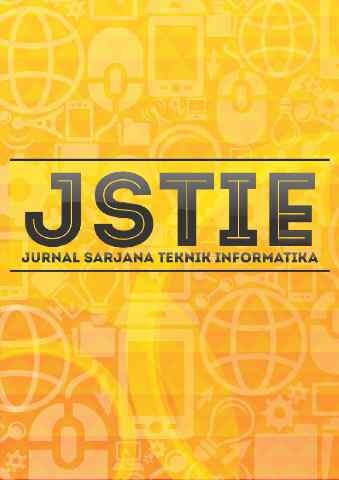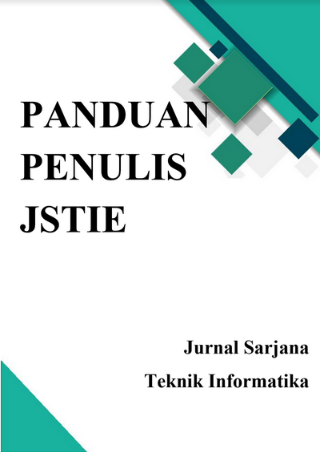Identifikasi Infeksi Penyakit Malaria Berdasarkan Citra Darah Menggunakan Convolutional Neural Network
DOI:
https://doi.org/10.12928/jstie.v10i2.22598Keywords:
convolutional neural network, citra, preprocessing, malariaAbstract
Malaria merupakan penyakit yang disebabkan oleh nyamuk anopheles yang terindetifikasi parasit plasmodium. Penyebaran kasus malaria yang semakin meningkat dapat dihentikan apabila terdapat sistem atau metode diagnosa secara akurat dan cepat. Tujuan penelitian ini adalah untuk mendeteksi sel darah merah yang terinfeksi malaria, untuk membantu tim kesehatan atau tim medis dalam mendiagnosa malaria dengan waktu yang lebih singkat serta menekan biaya peralatan medis serta mengurangi human error. Penelitian ini menggunakan convolutional neural network untuk mengklasifikasi citra sampel sel darah merah pasien positif malaria dan sampel sel darah normal. Tahapan penelitian dimulai dari identifikasi masalah, perumusan masalah, studi literatur, pengumpulan data di peroleh dari Kaggle.com dan NIH menggunakan kurang lebih 2000 data citra, spesifikasi kebutuhan, pengolahan data, perancangan model menggunakan arsitektur alexnet yang telah melalui proses reduksi dengan cara optimalisasi arsitektur CNN dan mencari kombinasi parameter yang menghasilkan nilai akurasi terbaik, implementasi menggunakan python, dan GUI flask serta pengujian performa sistem menggunakan akurasi dari confusion matrix. Hasil penelitian membuktikan pasien positif malaria dan pasien negatif malaria, menggunakan 80% data training serta 20% data testing dengan total dataset sebanyak 2000 data. Hasil akurasi sebesar 98% dan hasil uji validitas model menggukan data baru diluar data training dan testing didapatkan hasil akurasi sebesar 100%.
References
Tangpukdee, N., Duangdee, C., Wilairatana, P., & Krudsood, S. (2009). Malaria Diagnosis: A Brief Review. The Korean Journal of Parasitology, 47(2), 93. doi:10.3347/kjp.2009.47.2.93
Rinawati, W., & Henrika, F. (2019). Diagnosis Laboratorium Malaria. J Indon Med Assoc, 69(10), 327–335.
World Health Organization (WHO). 2019. World Malaria Report 2019. Technical report. World Health Organization Available at https://www.who.int/ publications/ i/item/world-malaria-report-2019.
Kusuma, W., Lestari, A. A. W., Herawati, S., Putu, I. W., & Yasa, S. (2000). Pemeriksaan Mikroskop Dan Tes Diagnostik Cepat Dalam Menegakkan Diagnosis Malaria. Work, 4(021), 57946053. http://www.jstor.org/stable/2883974%5Cnhttp://www.jstor.org/stable/2883974
Putra, S. R. (2015). Implementasi Convolutional Neural Network Untuk Klasifikasi Obyek Pada Citra. http://repository.its.ac.id/71292/1/5111100076-Undergraduate Thesis.pdf
Sabir, M. I. (2019). Pengaruh Image Engagement pada Aplikasi Parasit Malaria. Jurnal Penelitian Enjiniring, 22(1), 34–37. https://doi.org/10.25042/jpe.052018.06
Liang, Z., Powell, A., Ersoy, I., Poostchi, M., Silamut, K., Palaniappan, K., … Thoma, G. (2016). CNN-based image analysis for malaria diagnosis. 2016 IEEE International Conference on Bioinformatics and Biomedicine (BIBM). doi:10.1109/bibm.2016.7822567
Biantong, T. R., Furqon, M. T., & Soebroto, A. A. (2019). Implementasi Metode Support Vector Machine Untuk Klasifikasi Jenis Penyakit Malaria. Jurnal Pengembangan Teknologi Informasi Dan Ilmu Komputer (J-PTIIK) Universitas Brawijaya, 3(2), 1215–1224.
Ciresan, D., Meier, U., & Schmidhuber, J. (2012). Multi-column deep neural networks for image classification. 2012 IEEE Conference on Computer Vision and Pattern Recognition. doi:10.1109/cvpr.2012.6248110
Astini, N. K. S. (2018). Segmentasi Citra Parasit Malaria Plasmodium Vivax Dengan Menggunakan Metode Haar Cascade. Jl. Udayana Kampus Tengah, 0362, 27213. http://pti.undiksha.ac.id/senapati
Gopakumar, G. P., Swetha, M., Sai Siva, G., & Sai Subrahmanyam, G. R. K. (2018). Convolutional neural network-based malaria diagnosis from focus stack of blood smear images acquired using custom-built slide scanner. Journal of Biophotonics, 11(3). https://doi.org/10.1002/jbio.201700003
Sabilla, I. A. (2020). Arsitektur Convolutional Neural Network (Cnn) Untuk Klasifikasi Jenis Dan Kesegaran Buah Pada Neraca Buah. Tesis, 201510370311144, 1–119. https://repository.its.ac.id/73567/1/05111850010020-Master_Thesis.pdf
Putri, O. N. (2020). Implementasi metode cnn dalam klasifikasi gambar jamur pada analisis image processing.
NURHIKMAT, T. (2018). Implementasi Deep Learning Untuk Image Classification Menggunakan Algoritma Convolutional Neural Network (Cnn) Pada Citra Wayang Golek. Universitas Islam Indonesia, 10(2), 1–15. https://doi.org/10.13140/RG.2.2.10880.53768
Andika, L. A., Pratiwi, H., & Handajani, S. S. (2019). Lingga Aji Andika 1 , Hasih Pratiwi 2 , and Sri Sulistijowati Handajani 3 1. Indonesian Journal of Statistics and Its Applications, 3(3), 331–340
Faiz, F. A. (2019). Klasifikasi jenis kulit hewan asli dengan kulit imitasi berdasarkan citra tekstur permukaan samak kulit menggunakan convolutional neural network.
Sutrimah. (2017). Validitas Diagnosis Suspek Malaria Pada Pasien Demam Di Puskesmas Kaligesing Kabupaten Purworejo. 9–26. https://repository.unimus.ac.id
Downloads
Published
Issue
Section
License
License and Copyright Agreement
In submitting the manuscript to the journal, the authors certify that:
- They are authorized by their co-authors to enter into these arrangements.
- The work described has not been formally published before, except in the form of an abstract or as part of a published lecture, review, thesis, or overlay journal. Please also carefully read Journal Posting Your Article Policy.
- The work is not under consideration for publication elsewhere.
- The work has been approved by all the author(s) and by the responsible authorities – tacitly or explicitly – of the institutes where the work has been carried out.
- They secure the right to reproduce any material that has already been published or copyrighted elsewhere.
- They agree to the following license and copyright agreement.
Copyright
Authors who publish with Jurnal Sarjana Teknik Informatika agree to the following terms:
- Authors retain copyright and grant the journal right of first publication with the work simultaneously licensed under a Creative Commons Attribution License (CC BY-SA 4.0) that allows others to share the work with an acknowledgement of the work's authorship and initial publication in this journal.
- Authors are able to enter into separate, additional contractual arrangements for the non-exclusive distribution of the journal's published version of the work (e.g., post it to an institutional repository or publish it in a book), with an acknowledgement of its initial publication in this journal.
- Authors are permitted and encouraged to post their work online (e.g., in institutional repositories or on their website) prior to and during the submission process, as it can lead to productive exchanges, as well as earlier and greater citation of published work.








